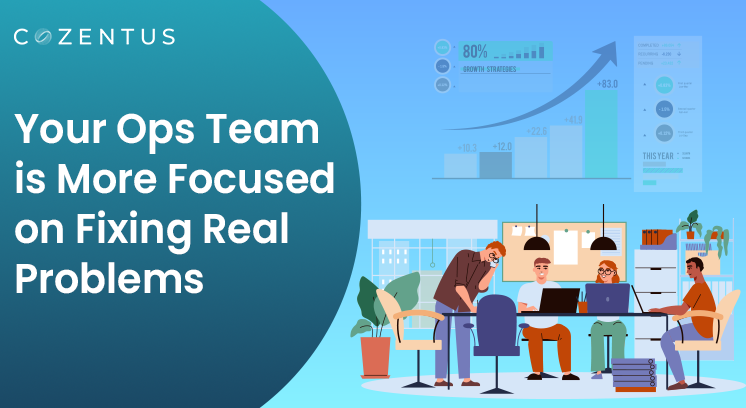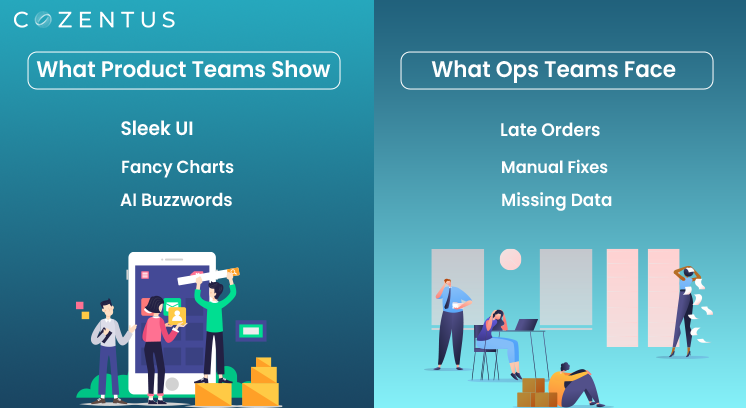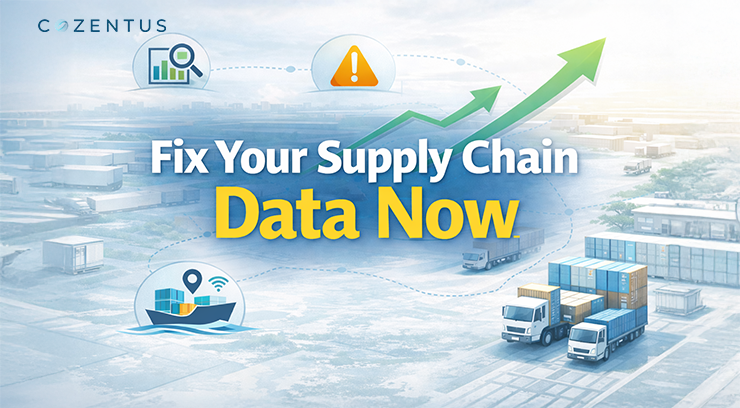Features Don’t Matter Until the Job Gets Done
Let’s say it like it is: your operations team doesn’t care about your product’s shiny new features.
And they’re absolutely right not to.
In the world of software and digital, it’s easy to get caught in the hype. Product teams and vendors love to showcase “what’s new” in every release. AI widgets, sleek dashboards, predictive models, or new toggles look impressive in a demo.
But ask someone on the delivery floor, managing shipments, resolving invoice mismatches, or juggling order delays, and you’ll often hear something different.
They’ll say: “We just want it to work.”
This isn’t resisting the change. It’s the voice of people who are closest to the problem. It’s the voice of pragmatism. And in truth, they might be the only ones in the room with their priorities in the right place.

Why Features Don’t Match the Real Requirement
When tools are designed in boardrooms or product war rooms, there’s a tendency to focus on what’s possible rather than what needs fixing. Features get added based on trends, sales demos, or competitive benchmarks—rarely on what operations teams actually need to do their job better today.
Here’s what happens when that disconnect grows:
- Tools feel a lot. Too many buttons. Too many choices. People spend more time figuring out what not to touch.
- Onboarding keeps on going. New team members need weeks to get comfortable with systems that should feel intuitive.
- Fixes get buried under "roadmap plans." That one pain point that slows down an ops process every day? Still pending, while a flashy new chatbot gets launched.
- And worst of all: product trust starts to diminish.
What Ops Actually Cares About
The operations team isn’t being stubborn. They’re being real.
Here’s what they actually value:
- Stability. Can I trust this tool not to crash during the process?
- Speed. Does this save me clicks? Reduce follow-ups? Flag issues before customers do?
- Visibility. Do I get a clear view of what’s working, what’s stuck, and what I need to act on?
- Control. Can I fix things myself, or am I waiting for support every time there’s a glitch?
If a feature doesn’t help with one of the above, it’s not required. And in logistics, manufacturing, or finance ops, unneeded things cost time, money, and peace of mind.
The Danger of “Feature Brag” Culture
Let’s talk about the elephant in the room: the obsession with features is often more about the seller than the buyer.
Too many tech pitches begin with “Look what we built,” instead of “Here’s what you deal with every day and here’s how we’re fixing it.”
We call it “feature brag” culture. Here’s what it looks like:
- Decks filled with jargon like “intelligent process”, “autonomous workflows”, “AI-powered processors”.
- Demos that avoid real-world problems and focus only on perfect data sets.
- Release notes packed with capabilities that sound impressive but are often not used.
None of this builds credibility with ops leaders. In fact, it does the opposite. It signals that you're not listening to the consumers.

Empathy Wins Over Everything
The most impactful tech projects don’t start with a list of features. They start with someone asking:
“What’s the most frustrating part of your day?”
When a platform or service team builds for the floor (and not just the forecast) it shows. You’ll hear things like:
- “This finally saves me time.”
- “I can trust this to run even when I’m not watching it.”
- “This makes handovers so much smoother.”
These are not emotional reactions. They’re business outcomes. Because when ops runs smoother:
- Delivery timelines improve.
- SLA breaches drop.
- Support tickets reduce.
- Customer complaints fall.
Build for the Process, Not the Presentation
If you’re building or buying software for operations, here’s a mental reset: it’s not about the presentation. It’s about the process. Every feature should answer one question:
- Does this make the process easier?
This applies across functions too:
- For logistics: Can I track my shipment without any exception?
- For finance: Can I reconcile payments without chasing multiple teams?
- For supply chain: Do I get real-time alerts when something goes wrong?
If the answer is “no,” it doesn’t matter how beautiful the interface looks or how futuristic the feature sounds. It’s just extra weight.
What Leaders Can Do Differently
Whether you're a C-suite executive, a product head, or a transformation sponsor, here’s how you can align your tech investments with ops reality:
- Walk the floor. Sit with the team. Watch how they work. Ask what slows them down.
- Redefine success. Replace “feature count” with “pain points solved” as your metric.
- Don’t chase trends blindly. AI, automation, and predictive analytics are all powerful. But only when applied to the right problems.
- Respect simplicity. The best tools don’t need manuals. If your teams can’t use it in real time, it’s not ready.
- Hold vendors accountable. Ask them to demo with your data, your process, and your constraints.
Final Thought: Respect the Ops POV
We need to normalize a new kind of product validation - one that starts from the trenches. The team that's closest to the work often has the clearest view of what needs to change.
So, the next time your product team celebrates a feature launch, pause and ask:
Did we actually make someone’s day easier?
If not, don’t be surprised if your ops team ignores it. They’re not being difficult. They’re just focused on what matters. And in a world filled with dashboards, features, and roadmaps - maybe they’re the only ones with their eyes on the real prize.
Ready to Fix What’s Actually Broken in Ops? Let’s Talk.
Recent Post
Subscribe to our newsletter
Stay updated on latest trends and news in the supply chain and logistics industry







